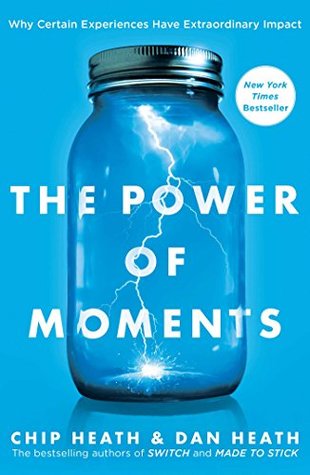More on this book
Community
Kindle Notes & Highlights
by
Chip Heath
Read between
April 2, 2019 - May 11, 2020
When people assess an experience, they tend to forget or ignore its length—a phenomenon called “duration neglect.” Instead, they seem to rate the experience based on two key moments: (1) the best or worst moment, known as the “peak”; and (2) the ending. Psychologists call it the “peak-end rule.”
What’s indisputable is that when we assess our experiences, we don’t average our minute-by-minute sensations. Rather, we tend to remember flagship moments: the peaks, the pits, and the transitions.
we spend weekend after weekend together with our kids, but in memory all those times blend together.
defining moments are created from one or more of the following four elements:
Defining moments rewire our understanding of ourselves or the world.
three situations that deserve punctuation: transitions, milestones, and pits.
you’re struggling to make a transition, create a defining moment that draws a dividing line between Old You and New You.
Transitions should be marked, milestones commemorated, and pits filled. That’s the essence of thinking in moments.
If you Elevate the Positives (Plan B), you’ll earn about 9 times more revenue than if you Eliminate the Negatives
To create fans, you need the remarkable, and that requires peaks.
The other difference between “breaking the script” and generic surprise is that the former forces us to think about the script. Our lives are filled with scripts: The script for how your family spends Sundays. The script for your team’s staff meetings. The script for a hotel check-in. To break the script, we’ve first got to understand the script.
If you’re looking to create memorable moments for your customers, you’ve got to break the script.
So how do you break the script consistently enough that it matters—but not so consistently that customers adapt to it? One solution is to introduce a bit of randomness.
they are evergreen—they can happen at any time and retain their power of elevation.
By breaking the script, we can lay down a richer set of memories. As the authors of the book Surprise put it, “We feel most comfortable when things are certain, but we feel most alive when they’re not.”
Tripping over the truth is an insight that packs an emotional wallop. When you have a sudden realization, one that you didn’t see coming, and one that you know viscerally is right, you’ve tripped over the truth. It’s a defining moment that in an instant can change the way you see the world.
Action leads to insight more often than insight leads to action.
Carolyn Wiley of Roosevelt University reviewed four similar studies of employee motivation conducted in 1946, 1980, 1986, and 1992. In each of the studies, employees were asked to rank the factors that motivated them. Popular answers included “interesting work,” “job security,” “good wages,” and “feeling of being in on things.” Across the studies, which spanned 46 years, only one factor was cited every time as among the top two motivators: “full appreciation of work done.”
When we talk about the need to recognize employees, we’re not aiming for one employee per month! The proper pace of recognition is weekly or even daily, not monthly or yearly.
most recognition should be personal, not programmatic. In our own research, when we asked people about the defining moments in their careers, we were struck by how often they cited simple, personal events.
Expressing gratitude pleases the recipient of the praise, of course, but it can also have a boomerang effect, elevating the spirits of the grateful person. Positive psychologists, who search for scientific ways to make people happier, have discovered the potency of what’s called a “gratitude visit.”
Hitting a milestone sparks pride. It should also spark a celebration—a moment of elevation. (Don’t forget that milestones, along with pits and transitions, are three natural defining moments that deserve extra attention.) Milestones deserve peaks.
Gentile’s approach to ethics says we usually know WHAT is right but don’t know HOW to act.
How do you design moments that knit groups together? Sharp’s leaders used three strategies: creating a synchronized moment, inviting shared struggle, and connecting to meaning.
many peak moments are, like the Sharp meeting, shared social moments: weddings, birthday parties, retirement celebrations, baptisms, festivals, graduations, rites of passage, concerts, competitions, and more.
if we can create the right kind of moment, relationships can change in an instant.
Responsiveness is not compatible with a canned agenda.
We hate being treated impersonally: You are not special. You’re a number.
what’s the payoff for all these moments? Can you measure it? Does it show up on the bottom line? Yes—think of all the tangible outcomes that have been created by better moments: More revenue (Forrester data, Southwest Airlines). Greater customer satisfaction and loyalty (Magic Castle). More motivated employees (data on recognition). More effective employees (purpose versus passion). And also many payoffs more personal in nature: More happiness (gratitude visits). Closer relationships (responsiveness). Self-transformation (Cinderella/ugly duckling moments in school, stretching for insight).
...more
the charge for all of us: to defy the forgettable flatness of everyday work and life by creating a few precious moments. What if every organization in the world offered new employees an unforgettable first-day experience?


